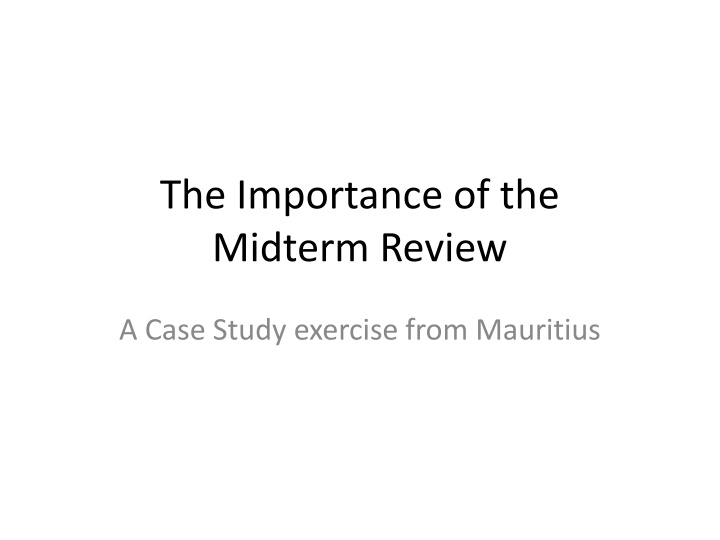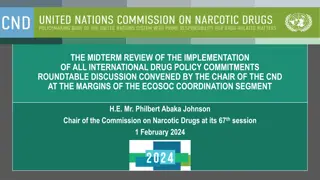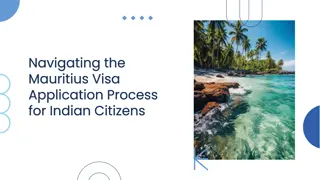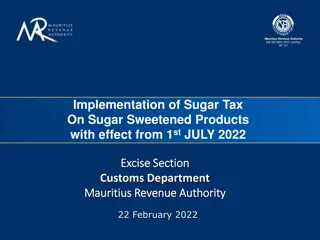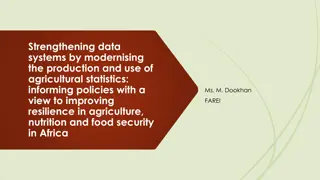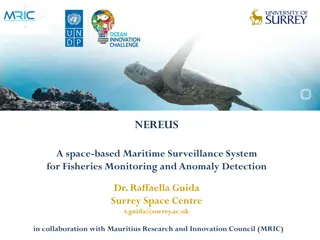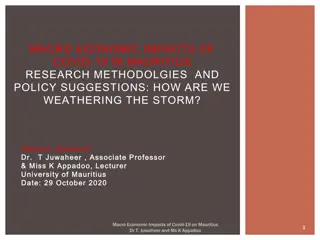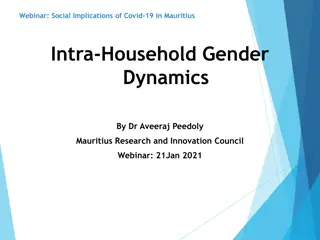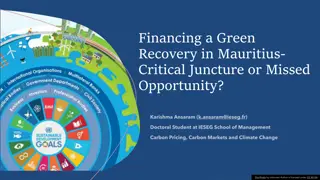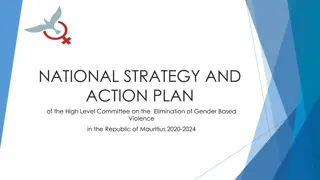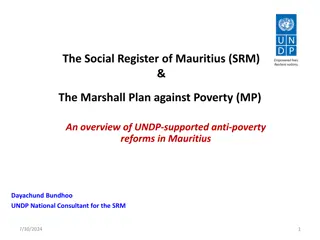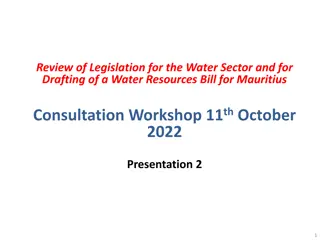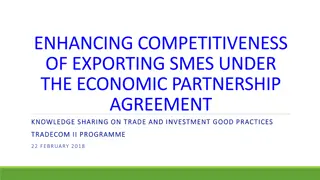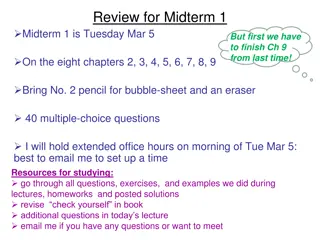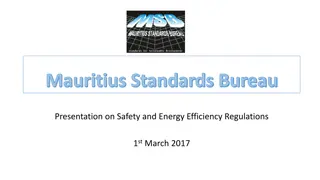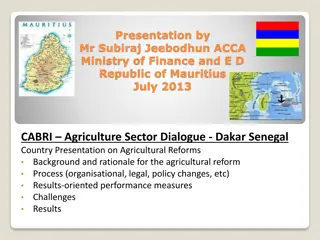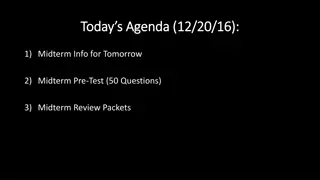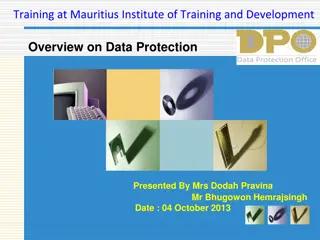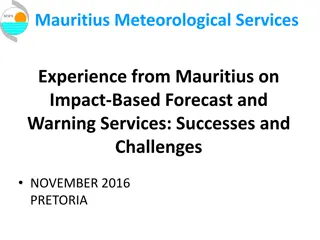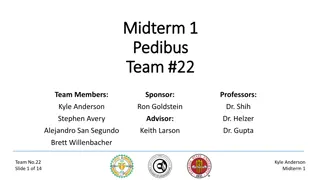Importance of Midterm Review in Project Management: Insights from a Mauritius Case Study
Explore the pivotal role of Midterm Reviews (MTRs) in project assessment, performance improvement, and strategic decision-making through a case study analysis focusing on the Management and Protection of the Endangered Marine Environment project in Mauritius. Discover how MTRs differentiate from other reporting mechanisms, who benefits from them, and how they drive positive change within projects. Uncover the key questions to be addressed in MTRs and their broader impact beyond individual projects.
Download Presentation

Please find below an Image/Link to download the presentation.
The content on the website is provided AS IS for your information and personal use only. It may not be sold, licensed, or shared on other websites without obtaining consent from the author.If you encounter any issues during the download, it is possible that the publisher has removed the file from their server.
You are allowed to download the files provided on this website for personal or commercial use, subject to the condition that they are used lawfully. All files are the property of their respective owners.
The content on the website is provided AS IS for your information and personal use only. It may not be sold, licensed, or shared on other websites without obtaining consent from the author.
E N D
Presentation Transcript
The Importance of the Midterm Review A Case Study exercise from Mauritius
The Importance of the Midterm Review from Agencies Point of View UNDP-GEF Regional Technical Advisers often say to project teams, The Terminal Evaluation is important for the GEF to see what was achieved for their investment. The Midterm Review is important for you and for UNDP because if performance is poor, we can still turn things around.
Questions about the Midterm Review (MTR) 1. What makes the MTR different from other reporting requirements? 2. Who benefits from the MTR and how? 3. How can the MTR catalyze change in a project? 4. What questions should be asked by the MTR? 5. Beyond the scope of a single project, how can MTR reports be used? A case study will help us answer these questions...
A Case Study from Mauritius The Management and Protection of the Endangered Marine Environment of the Republic of Mauritius GEF funded UNDP implemented Medium-Sized Project Focal area: Biodiversity GEF Strategic Priority: SP1 (Protected Areas) Total GEF Grant: US$ 1.00 million Total Co-financing: US$ 3.36 million at CEO Approval stage US$ 3.0 million effectively mobilised
A Case Study from Mauritius Background Project Summary & Context Applied a two-prong approach: 1) Develop an enabling policy and institutional framework for sustainably co-managed MPAs throughout the Republic; and 2) Develop innovative co-management arrangements for MPAs and adapt them at a representative demonstration site in Rodrigues. Faced many complexities: the two components were implemented by different national entities collaborative co-management was new and innovative in the country many partners were involved: Government, local communities, private sector Active management of MPAs was new to the country at project start and there were no MPAs on Rodrigues Island Required a significant amount of technical know-how to reach its targets
A Case Study from Mauritius Background Project Milestones GEF CEO Endorsement ProDoc Signature First disbursement Original Closing Actual Closing August 2003 January 2004 2005 June 2008 Sept 2012
A Case Study from Mauritius Background Annual Disbursement Peak implementation Annual Disbursements by Funding Source
A Case Study from Mauritius Background M&E Milestones First PIR Midterm Evaluation Final PIR/Terminal Evaluation Sept 2005 June 2008 Sept 2012 Period of most intense implementation 2003 2004 2005 2006 2007 2008 2009 2010 2011 2012 Effective implementation period
A Case Study from Mauritius The MTE A turning point Rated the project Marginally Unsatisfactory (MU) Revealed the reasons for delays, and solutions Provided specific and detailed recommendations Findings and recommendations were embraced by project team, UNDP, other partners Continuation of the project made conditional on the implementation of the recommendations Described as a turning point by the TE report
A Case Study from Mauritius Notable Findings of the MTE Difficult to achieve Outcome 1 in the political, administrative, legal context (decentralisation implying new roles and mandates) needs to be redesigned and focused on MPAs, to maintain relevance activities not started Design of Outcome 2 highly relevant generally high levels of commitment, enthusiasm some outputs with good progress, e.g. on Rodrigues in developing a co- management approach to MPA establishment and management Delays in implementation have meant that it was too early to see any real achievements under the Outcomes Only 3 of the 10 outputs were sufficiently advanced to show progress; rated MS Large backlog of activities not yet undertaken Significant under-expenditure; advantageous in that it would allow for an adjustment of the budget to take on additional assistance for the final phase Lack of working examples in country required boosting capacities at all levels for managing a project of this size In particular full time Technical Advisor with MPA know-how was not in team
A Case Study from Mauritius How did the MTE catalyze the change? MTE was thorough and specific in raising flags about the project s poor performance and trends Outlined actionable and concrete recommendations: to establish a new position within the project to support the PMU, and provide training and capacity building; bring in outside expertise on MPAs to finalize the project s M&E plan and review the Logical Framework to undertake a comprehensive training needs assessment to revise activities under Outcome 1 and prepare a workplan to initiate the process for preparing the draft management plan for SEMPA Revealed ways in which the country could drive a turnaround in the project, e.g. stressed the need for political commitment These and other recommendations were immediately acted on by Government partners, UNDP and project team, bringing about major improvements in implementation
A Case Study from Mauritius After the MTE... Logframe streamlined and made more results- oriented with clearer and SMART er indicators Systematic tracking of MTE management response Consolidation of key project outputs successful zoning of the MPA and its enforcement development of key MPA planning documents implementation of key activities in Component 1, which had seen no progress till the MTE. Multi-year budgetary planning enforced New Chief Technical Adviser engaged Marginally Satisfactory (MS) overall rating from TE, with some Highly Satisfactory (HS) components
A Case Study from Mauritius Highlights of the Project s Results Establishment of the South-East Marine Protected Area (SEMPA) across 4,200 ha Improved management effectiveness of SEMPA (METT score rose from 7% to 81%) Developed innovative co-management arrangements for marine PAs Increased communities sense of ownership of the MPAs; approximately 50 families are now directly involved in MPA activities Supported the recruitment of fishermen as Field Rangers, offering an alternative livelihood Reduced pressures on marine resources; independent monitoring confirms that MPA zones are adhered to and infractions are reported and penalized
Questions about the Midterm Review (MTR) 1. What makes the MTR different from other reporting requirements? 2. Who benefits from the MTR and how? 3. How can the MTR catalyze change in a project? 4. What questions should be asked by the MTR? 5. Beyond the scope of a single project, how can MTR reports be used?
Answers... 1. What makes the MTR different from other reporting requirements? independent and holistic assessment gives a fresh, unbiased view of the project identifies potential for improvement produces actionable, realistic, results-oriented and concrete recommendations completed when the project still has time to recover and improve presents a learning opportunity for all involved
Answers... 2. Who benefits from the MTR and how? all stakeholders it could be the difference between make-or-break the project team MTR as a learning exercise for improving performance and achieving results the Government providing specific policy guidance, promoting efficiency and informing decision-making the project partners rethinking their role and contribution to project results the GEF agency as a tool for institutional learning and identification of needed solutions
Answers... 3. How can the MTR catalyze change in a project? Reviewing project design/assumptions in light of changed circumstances and adjusting design accordingly inspiring the project team and partners through recognition of the project s relevance proposing concrete and actionable recommendations outlining how those recommended changes have the potential to improve the project s results
Answers... 4. What questions should be asked by the MTR? Are there signs of advances towards the outcomes? What progress does the midterm GEF Tracking Tool show? What challenges are causing delays? What has changed in the context? Is the project still relevant? Are there new opportunities? How can the challenges be overcome? Is it feasible to complete with the remaining resources and the existing context?
Answers... 5. Beyond the scope of a single project, how can MTR reports be used? Learning: to reveal trends across a portfolio from which overarching lessons can be extracted and change thereby promoted Results: to summarize mid-point results, which can be aggregated at the portfolio level Knowledge: to advance our understanding of the hurdles faced by projects during implementation
